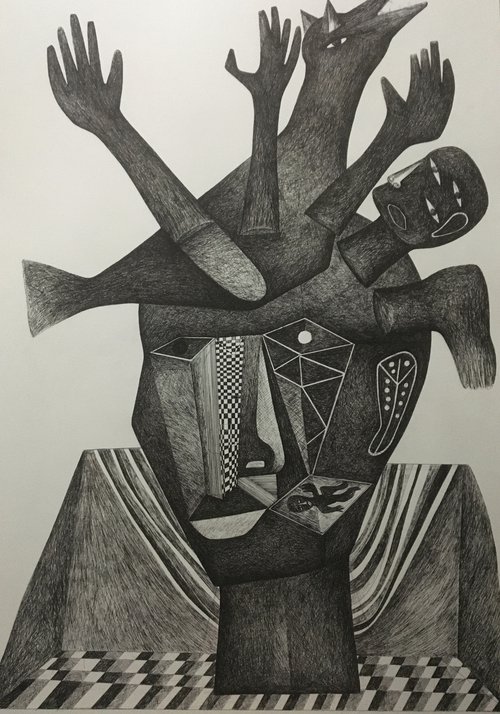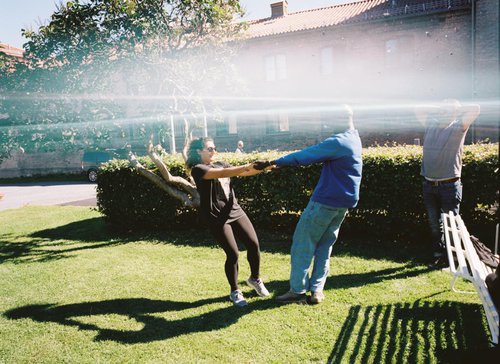Artist Spotlight: Khalid Shatta
“We are all an artist in what we love, but in a different way.”
Khalid "Shatta" is a Norway-based visual artist who uses painting as his primary form of creative expression. Originally from Nuba mountains in Sudan, he is known for his large canvases, colorful motifs, and modernist art.
For Shatta, art is an essential way of communicating to the world and to himself. “It is a side of language, for me sometimes it’s hard to say the words but it is something that I can say through painting. Art is the silent language of the self that can be expressed in different ways through art […] I think it’s the inner power of understanding my journey in life.”
The history of ancient civilizations and the interconnectedness of the world are some main themes that drive his work. Shatta reflects a lot on his place of origin the Nuba mountains in Sudan and their rich culture and history as being home to one of the earliest human civilizations. Examining the past in the context of the present helps him understand his place in the world. “I like to go back to the foundation of everything and focus more on the essence rather than the image. […] We are the product of our ancestors, we are all a part of what is going on right now. It’s a beautiful thing to understand those kinds of processes that led to who l we become today. So that is why I drew the series Migration of the Soul.”

When Shatta refers to migration, he does not refer to physical migration, although that it something he has experienced, but rather ‘the sensation of being out of place’. This painting in the series came at a significant yet difficult time of his life and was a way to process the trauma and disconnection he felt. Shatta elaborates: “As you can see, there is one body, but there are three faces. Three faces trying to fit in one body.”
Shatta finds inspiration ‘everywhere’ but especially through movies, dancing, music and exploring history. However, he adds that he is not always ready to receive inspiration: “It’s about how calm my thoughts are and how I can open my eyes and see that. Sometimes, I get busy with my own things and then the beauty is distracted.” Usually, he laughs, “it just comes, I don’t know how! It’s hard to explain!”
Right now, Shatta explains that he feels a bit lost in his creative practice: “Especially for people like me who came from war or who came from harsh situations, sometimes they may struggle for a long time. In these times it takes time to understand and to adapt. To understand how your things became you know, you need to understand where you came from too.” He is looking for space both physical and mental. He explains his recent work with ceramics and his need to create larger pieces that take up space. “I need to make sculptures, big sculptures and big paintings. Sometimes a lack of materials and space can stop you from making.” Big paintings are fun, he explains further, “When the idea comes, it makes you stop thinking about size. Makes it more exciting to see how you’re going to end it.”

Photography
Shatta is not only a painter and sculpturer but also a photographer. While studying in the Art College Khartoum, he started experimenting with film and digital photography. One of the central themes he explored was the intimate connections between nature / humans and childhood in his native Nuba mountains.

He sees connections between painting and photography but recognizes significant differences between the two. “It’s an important tool, it gives the chance to people who do not draw or paint, to picture and capture the moment of something. But painting, is painting.” The significant difference – painting feels like creating something he can truly call his own. The perseverance of sculptures and art forms of old civilizations is something that we often return to during our conversation. There have always been many forms of art and photography today is a powerful tool. Yet, it still feels more impermanent, we laugh: you can lose the camera and everything in it will disappear!
He appreciates the freedom that all his art mediums inherently possess “I don’t need to explain what my painting is, you can see my art and you are free to see whatever you want to.” In his art he does not feel like he needs to explain his practice to anyone, even to himself. “Sometimes I feel like I don’t even need to understand, it’s just nice to paint and draw.”
Residencies & the future
The R22 - Repression – Expression // Violence – Creative Resistance Residency, co-organized by the INSPIRE Research Project (PRIO), PRAKSIS and Motaz Al Habbash was Shatta's first residency and a new experience for him. The residency took place in August/September 2022 and Shatta explains he still needs more time to explore his personal experience. Residents were able to explore not only different artistic mediums, but also one another's perspectives and experiences. In that way he explains the essence of the residency was ‘about human connection’.
Shatta comments on how he was inspired by his fellow residents. “The way they are trying to express their journey through art, music and performance, it is something touching.” His conversations with other residents illuminated different perspectives and challenged his understanding of issues such as statelessness and the Palestinian struggle, which in Sudan he had learned about in a one-sided way. Thus, through the residency artists were able to move beyond stereotypes and connect over common struggles and stories.

“I enjoyed it because it is important for human beings, we need to see things through a naked eye, without beliefs and ethnicities, because human is human. When you mix in beliefs it makes it complicated. We are always different in what we believe but we are together as humans. We all have the right to live in this world, to enjoy our lifetimes.”
His experiences in Norway have changed his perspective of home. The peaceful environment has allowed him to see and experience the beauty of nature, particularly the mountains, which remind him of his Nuba mountains home and the challenge of experiencing the same beauty due to conflict.
Shatta dreams of one day being able to open an art school in the Nuba mountains, a free art space for kids: “There is strong power in art. The more people understand it, the more they can understand themselves.” He explains how art is not valued in the educational system in Sudan, which is surprising considering the rich historical role of art in Sudan.
Since our interview and Shatta’s INSPIRE seminar at PRIO in March 2023 the situation in Sudan has drastically worsened with fighting erupting between factions and civilians getting caught in the middle. In a recent conversation Shatta reflects on the situation: “There will always be a place for art, in harsh or peaceful times.” However, he adds: “It’s a dirty game, this war. It’s sad to see young people panicking about their future.
He is working on a painting called “it’s a war”. “People always think about what war looks like but not so much about what makes humans pursue that behavior. War has a mask. The image of war as sad and violent is ‘easy’ but there is much more going on, everything is connected.” The painting is large, busy and multilayered. The outline of a building structure also looks like the shadow of a gun, a green field with flowers stands out amongst the dark colours,
“It’s not about understanding what is going on but feeling it – there is no correct way of understanding what is going on because things change all the time. That’s what I am trying to do here, you see familiar nature, trees, flowers, buildings, people… then you see their expressions and you question yourself.”
The painting is still a work in progress, but you can find it and others on his Instagram and Facebook pages.
There is great uncertainty on what the future will being, in the meantime Shatta is joining the Rotterdam residency in August/September and he is greatly looking forward to it. In his words:
“Art is the only language I understand. I have tried many things and I can be successful in many things, but I get stressed and tired. I never get tired of making art. I feel peaceful in that way.”